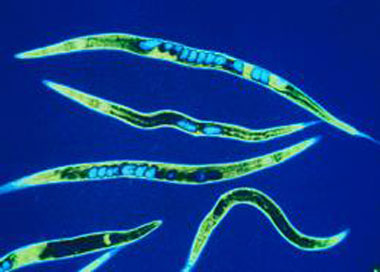| Jun 02, 2011 |
Microscopic worms could help open up travel into deep space
|
|
(Nanowerk News) A space flight by millions of microscopic worms could help us overcome the numerous threats posed to human health by space travel. The Caenorhabditis elegans (C. elegans) have also given experts an insight into how to block muscle degradation in the sick and elderly.
|
|
The worms — from The University of Nottingham — were flown into space onboard the Space Shuttle Atlantis. They spent 11 days in orbit onboard the International Space Station more than 200 miles above the earth.
|
 |
| Researchers are exploring alternative experimental systems to C. elegans. (James King-Holmes / Science Photo Library)
|
|
Many of C. elegans' 20,000 genes perform the same functions as those in humans. Experts in human physiology from the School of Graduate Entry Medicine wanted to study the effectiveness of RNA interference (RNAi), a tried and tested technique which regulates gene expression in diseased tissue, and whether this technique could be employed to reduce or control the dramatic muscle loss experienced by astronauts during spaceflight.
|
|
The results of this research, published today (June 1 2011) in the journal PLoS ONE ("The Effectiveness of RNAi in Caenorhabditis elegans Is Maintained during Spaceflight"), have shown that RNAi, which is already the subject of more than a dozen clinical trials to target illnesses ranging from cancer to asthma, functions normally in space flight and could be used as a viable option to treat and control muscle degradation in spaceflight. Their discovery will not only be of interest to astronauts but will also help people who suffer from muscle wasting caused by illness and old age.
|
|
Dr Nathaniel Szewczyk from the Division of Clinical Physiology said: "It was really a quite straightforward experiment. Once the worms were in space the scientists onboard the International Space Station treated them with RNAi and then returned them to us for post flight analysis. These results are very exciting as they provide a valuable experimental tool for spaceflight research and clearly demonstrate that RNAi can be used effectively to block proteins which are needed for muscle to shrink."
|
|
During the flight a series of experiments were carried out by Japanese scientists onboard the International Space Station. When the flight samples were returned to Nottingham the results were analysed by Dr Timothy Etheridge, in the Division of Clinical Physiology.
|
|
Timothy Etheridge said: "We were very pleased that, given the numerous problems associated with conducting research in space, our experiments went as planned and allowed us to demonstrate that this form of gene therapy works effectively during spaceflight. The unexpected finding that RNAi can effectively block protein degradation in muscle in space was also a very welcome surprise."
|

